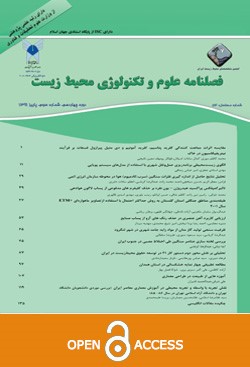An analysis of urban public spaces exptation to reduce Vandalism
Subject Areas :
Architecture and urbanism
sahar esmaeilpourhamedani
1
 ,
esmail shieh
2
*
,
Kianoosh Zakerhaghighi
3
,
esmail shieh
2
*
,
Kianoosh Zakerhaghighi
3
1 - phd scholar Department of Urban planning, Islamic Azad University, Tehran West Branch, Tehran, Iran urban planning & urban design
2 - Professor and faculty Department of Urban planning, Islamic Azad University, Tehran West Branch, Tehran, Iran. *(Corresponding Author)
3 - Associate professor Department of Urban planning, Islamic azad university, Hamedan branch, Hamedan, Iran.
Received: 2019-03-09
Accepted : 2020-05-26
Published : 2023-01-21
Keywords:
care and maintenance,
Situation,
Vandalism,
Public urban spaces,
Enclosure,
Abstract :
Background and Objective: The patterns of people's behavior in urban public spaces are based on the role of location and situation. In other words, the place induces human behavior and actions in space. Vandalism as a subset of crime and one of the most important problems in cities.
Material and Methodology: The documentary method is an analytical method that uses Correlation to study the ratio of variables. The case study strategy is and the paradigm is positive. Locations and the extent of vandalism in urban public spaces with the most potential vandalism people have been investigated and evaluated. The collection of qualitative and quantitative data is objectively and subjective, which is dealt with by the etic approach to the conception of as a matter of fact and as a matter of perception. The case study is a part of the urban public spaces of Hamadan district, which mainly focus on the use of boys' instructional skills, aged 15 to 25 in terms of gender, boys and men, and sex, income, and community base at the lower level of society. Data analysis using the Anova-based spss software is the most effective index of choice among selected indicators through exploratory factor analysis and through the regression analysis, the effectiveness of each of the factors is determined.
Findings: The findings of the data analysis indicate that, Location, Enclosure, care and maintenance of urban public spaces are effective in reducing Vandalism tendencies and consequently the rate of occurrence of Vandalism behaviors.
Discussion and Conclusion: It can be said that the findings of this study are consistent with theoretical expectations and literature reviw. The first priority of the effectiveness was assessed, which should be policy and strategies by researchers, urban designers and urban planners to reduce the spatial effects of these components on the incidence of vandalism behaviors in urban public spaces.
References:
Mohseni Tabrizi, Alireza, (2005). Vandalism, basic of social psychology. Tehran: Iran. (In Persian)
Fathi, Soroosh, Mohammadi, Hamed. (2011). Burgess, social foreigness &vandalistic behavior in youngers. [in Persian] Social research periodical. 13:157-171.
Esmaeilpoor Hamedani. Sahar, Bandarabad, Alireza. (2017). Analyze the determinatives on vandalist with purpose improve quality of urban public space Case study: kababian neighborhood in Hamedan [in Persian] Human Geography .9:163-179.
Weisburd, D. L., Groff, E. R., & Yang, S. -M. (2012). The criminology of place: Street segments and our understanding of the crime problem. Oxford; New York: OUP US.
Andresen, M., & Malleson, N. (2011). Testing the stability of crime patterns: Implications for theory and policy. Journal of Research in Crime and Delinquency, 48, 58–82.
Sherman, L.W., Gartin, P. R., & Buerger, M. E. (1989). Hot spots of predatory crime: Routine activities and the criminology of place. Criminology, 27, 27–5.
Weisburd, D., & Amram, S. (2014). The lawof concentrations of crime at place: The case of Tel Aviv-Jaffa. Police Practice and Research, 15, 101–114.
Felson, M., & Newton, A. (2015). Crime patterns in time and space: The dynamics of crime opportunities in urban areas. Special issue. Crime Science, 4.
Mohseni tabrizi, alireza, (2001). Catechism of vandalism. Review of finding a research. (In Persian) Sociality sience.16:193-227.
Timothy, C.and O’Shea .2006. Physical deterioration, disorder, and crime. university of south alabam
Maghsoodi, soode, banifatemeh, Zahra. (2003). Analysis of the content of vandalism and wall-classes in the classrooms of the Shahid Bahonar University of Kerman. (In Persian) Social Welfare.13.
Liewelyn Davies. Safer places: the planning system and crime prevention, c 2004.
Tavasoli. Mahmood. (1997). Principles and methods of urban design and residential spaces in Iran. Center for Urban and Architecture Studies and Research.
Carmona, Matthew and at. (2003). public spaces urban spaces the demnsions of urban design.
Thompson, Kirrilly, Offler, Naomi, Hirscha, Lily, Daniell, Everya, Matthew,2012, From broken windows to a renovated research agenda: A review of the literature on vandalism and graffiti in the rail industry, J. ThomasaDrewDawsona
LiHe, Antonio, Pez, Desheng Liuc, 2017. Built environment and violent crime: An environmental audit approach using Google Street View, Volume 66, November 2017, Pages 83-95.
Hoseini. Seyed bagher, kameli, mohsen. (2012). Spatial Analysis of Contemplation, Conflict and Evil Causes by Geographic Information System (Case Study: Qom City). Law Enforcement.3:73-89.
Sadeghi, yadollah and at. (2014). Transformation of crime studies through environmental design (cpted) inside (In Persian) Human Geography.2:153-170.
Jeykobz, jen, (2003). The death and life of big American cities. (In Persian)
Gorden, Collen, (1998). Selection of urban landscape. (In Persian)
Habib pour karam, safari shali, reza, (2010). Comprehensive SPSS Application Guide in Survey Research (Quantitative Data Analysis). (In Persian)
_||_
Mohseni Tabrizi, Alireza, (2005). Vandalism, basic of social psychology. Tehran: Iran. (In Persian)
Fathi, Soroosh, Mohammadi, Hamed. (2011). Burgess, social foreigness &vandalistic behavior in youngers. [in Persian] Social research periodical. 13:157-171.
Esmaeilpoor Hamedani. Sahar, Bandarabad, Alireza. (2017). Analyze the determinatives on vandalist with purpose improve quality of urban public space Case study: kababian neighborhood in Hamedan [in Persian] Human Geography .9:163-179.
Weisburd, D. L., Groff, E. R., & Yang, S. -M. (2012). The criminology of place: Street segments and our understanding of the crime problem. Oxford; New York: OUP US.
Andresen, M., & Malleson, N. (2011). Testing the stability of crime patterns: Implications for theory and policy. Journal of Research in Crime and Delinquency, 48, 58–82.
Sherman, L.W., Gartin, P. R., & Buerger, M. E. (1989). Hot spots of predatory crime: Routine activities and the criminology of place. Criminology, 27, 27–5.
Weisburd, D., & Amram, S. (2014). The lawof concentrations of crime at place: The case of Tel Aviv-Jaffa. Police Practice and Research, 15, 101–114.
Felson, M., & Newton, A. (2015). Crime patterns in time and space: The dynamics of crime opportunities in urban areas. Special issue. Crime Science, 4.
Mohseni tabrizi, alireza, (2001). Catechism of vandalism. Review of finding a research. (In Persian) Sociality sience.16:193-227.
Timothy, C.and O’Shea .2006. Physical deterioration, disorder, and crime. university of south alabam
Maghsoodi, soode, banifatemeh, Zahra. (2003). Analysis of the content of vandalism and wall-classes in the classrooms of the Shahid Bahonar University of Kerman. (In Persian) Social Welfare.13.
Liewelyn Davies. Safer places: the planning system and crime prevention, c 2004.
Tavasoli. Mahmood. (1997). Principles and methods of urban design and residential spaces in Iran. Center for Urban and Architecture Studies and Research.
Carmona, Matthew and at. (2003). public spaces urban spaces the demnsions of urban design.
Thompson, Kirrilly, Offler, Naomi, Hirscha, Lily, Daniell, Everya, Matthew,2012, From broken windows to a renovated research agenda: A review of the literature on vandalism and graffiti in the rail industry, J. ThomasaDrewDawsona
LiHe, Antonio, Pez, Desheng Liuc, 2017. Built environment and violent crime: An environmental audit approach using Google Street View, Volume 66, November 2017, Pages 83-95.
Hoseini. Seyed bagher, kameli, mohsen. (2012). Spatial Analysis of Contemplation, Conflict and Evil Causes by Geographic Information System (Case Study: Qom City). Law Enforcement.3:73-89.
Sadeghi, yadollah and at. (2014). Transformation of crime studies through environmental design (cpted) inside (In Persian) Human Geography.2:153-170.
Jeykobz, jen, (2003). The death and life of big American cities. (In Persian)
Gorden, Collen, (1998). Selection of urban landscape. (In Persian)
Habib pour karam, safari shali, reza, (2010). Comprehensive SPSS Application Guide in Survey Research (Quantitative Data Analysis). (In Persian)
![]() ,
esmail shieh
2
*
,
Kianoosh Zakerhaghighi
3
,
esmail shieh
2
*
,
Kianoosh Zakerhaghighi
3

